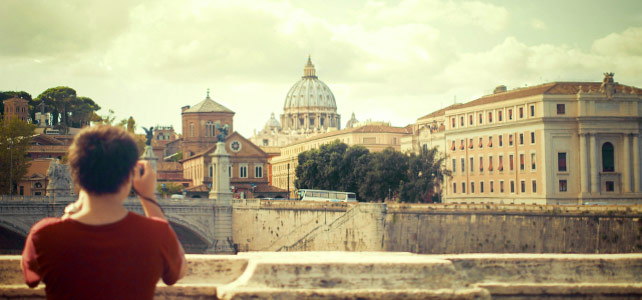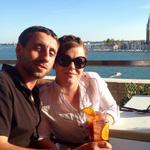 Rome from a tour guide’s perspective:
Rome from a tour guide’s perspective:– Relax, have your first cappuccino, walk around via condotti, spagna, navona, trevi, and pantheon
– Visit the Roman forum, Palatine hill, Colosseo
– Spend all day at the Vatican museums
This is the standard itinerary that pre-occupies all visitors to Rome-“Can we do it all in two days?” Yes, it’s possible, and I’ve done all of that and more in 6 hours. Not my favorite tour, but none of these sights should be missed when you visit Rome. At this point though, I must stress that there is a good reason why Rome is called the Eternal City– It is a huge, vast city where layer upon layer of history weave themselves through cobbled streets full of tourists, locals, clergy and traffic. Impossible to understand and comprehend in a few days, weeks, and as I now know, years, Rome requires a lifetime visit. So don’t dare be sated by that tiny list, and don’t be surprised to find yourself thinking about the things you want to do on your next visit.
The good news is, every Tour Italy Now escorted tour has plenty of “Free time” built in for exploring. So step out of the sandy ruins of the Ancient City, clear your mind of the limitless artwork you’ve seen at the Vatican and breathe in the real atmosphere of this ever-changing, yet ever-constant contradiction of a city. We’ve put together some alternative itineraries to consider:
“Have Bike, will Travel” Bicycle is the best way to see Rome. For a relaxing day with hardly any walking, go to Villa Borghese and rent a bicycle for two (or four). Villa Borghese is truly the center of Rome, the place where everyone comes to relax on a sunny day. In the center of the park, by viale dei Puppazzi is Café L’Orologio, an old-fashioned, under the trees café. Near by is the Teatro di Burratini, a puppet theatre for children and adults. The concession stand always has home-made cotton candy (zucchero filao). Walk down Viale del Lago to the laghetto, a mini-lake with boat rides. Watch the local dogs play in the Valle dei Cuccioli, near Rome’s Zoo. Not to be missed is Galleria Borghese, a beautiful 17th century palazzo dedicated to paintings and sculpture from artists such as Bernini and Caravaggio. Towards the northern boundary of the park is the Galleria Nazionale di Arte Moderna, the National Art Galleria with a collection of modern art from the 18th century to present. If you don’t have time for modern art, just grab a café and pastry at Caffe delle Arti, a beautiful terrace café nestled between tall Corinthian columns. To end your afternoon, walk towards Porta Pinciana and look for the hot air balloon, get in line shortly before sunset for the last ride of the day. Modelled from an 18th century design, the Aerophile 5500 Hot Air Balloon ascends 150 meters above Rome, overlooking the entire city.
Villa Borghese at Night: Globe Theatre hosts Shakespearean plays every evening during the warmer months.
Where: Villa Borghese (Metro A, Spagna, Bus 116)
“As Odd As It Gets”
With a day to kill, Rome’s slightly dark side is worth a few crowded metro rides, bumpy buses and some extra walking. Deep down, everyone wants to see something different, sometimes not entirely beautiful, and often times creepy. Rome is indeed the most gorgeous city in the world, what makes it so is that it embraces its beauty, but Rome also cherishes its ghosts.
1. Santa Maria della Concezione, Via Veneto (closed Thursdays)– a 17th century church decorated by major artists from the Baroque era. Take a look at Guido Reni’s St. Michael. Below are the more famous crypts of the Capuchin monks, a Franciscan order who buried the bones of their brothers. The crypts are entirely decorated with the bones of the monks, making the experience rather creepy. One tomb is dedicated with the following “What we once were you are, what we are now, you will be.quot Metro A- Barberini
2. Cimitero Acattolico – Non-catholic’s cemetery in Testastaccio, via Caio Cestio. A well known place for foreigners (non-catholics) to be buried such as Percy Shelley and John Keats. Masses were held clandestinely and most graves were modestly marked. For example, Keats’ grave reads: “This grave contains all that was Mortal of a YOUNG ENGLISH POET who on his Death Bed, in the Bitterness of his Heart at the Malicious Power of His Enemies, Desired these Words to be engraved on his Tomb Stone “Here lies One Whose Name was writ in Water.” Feb 24th, 1821. Metro B- Piramide
3. Piramide of Caio Cestio. At the end of the 1st century, Caio Cestio Epulone had a piramide constructed in his memory in just 330 days. Perhaps it won’t give you goosebumps, but it is odd.
4. Catacombs of San Sebastiano: Taking a bike/car/bus trip down via Appia Antica shows off the prestigious family tombs that look like castles (Cecila Metella) and leads to the Basilica di San Sebastiano with its catacombs, necropolis and red wall. Bus 280 at Piramide and via Marmorata will get you there.
5. The Necropolis and Sacred Grotto (under St. Peter’s Basilica). If you know the dates of your trip, book this tour well in advance as there is limited entrance into the moisture-controlled Scavi# excavation of the 1st century AD necropolis where the bones of St. Peter have been found. The tour is fantastic as you are several meters underground, walking through a well-preserved necropolis. As part of your visit, you will also see the tombs of several popes. Take Metro A- Ottaviano
6. Museum of the Souls of Purgatory, in Chiesa del Sacro Cuore del Suffragio (a Gothic-looking church on Lungotevere Prati, 12 near Piazza Cavour). The museum is more like a small room, in the back of the church, which contains objects and photos that show traces made by souls in Purgatorio to those still left on earth. This one makes you think a bit. Just a brief walk down the Tevere from Castel Sant’Angelo.
These next itineraries, and many more including the upcoming “Roads Less Traveled”, “Underground Rome” and “Simple Trip to Rome”, are best accompanied by Rome, Little Black Book, Rome’s friendly, neighborhood dining and entertainment guide. Take a less traveled path, get out of the regular group tour, make your own Roman experience -and while you’re at it, peruse Little Black Book which will help you find what you want to eat, wherever you are. It doesn’t tell you where to go, but helps you find out for yourself.





